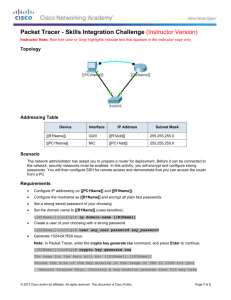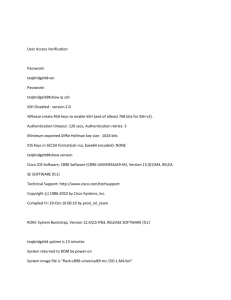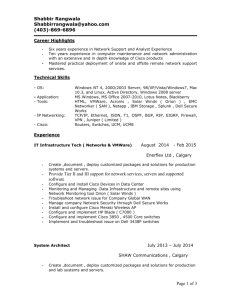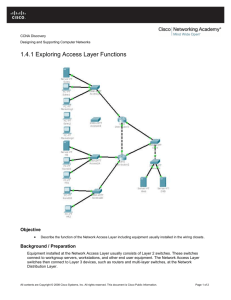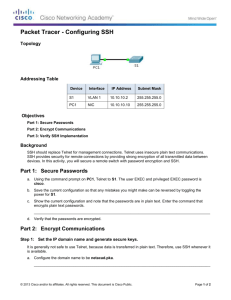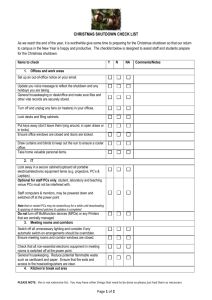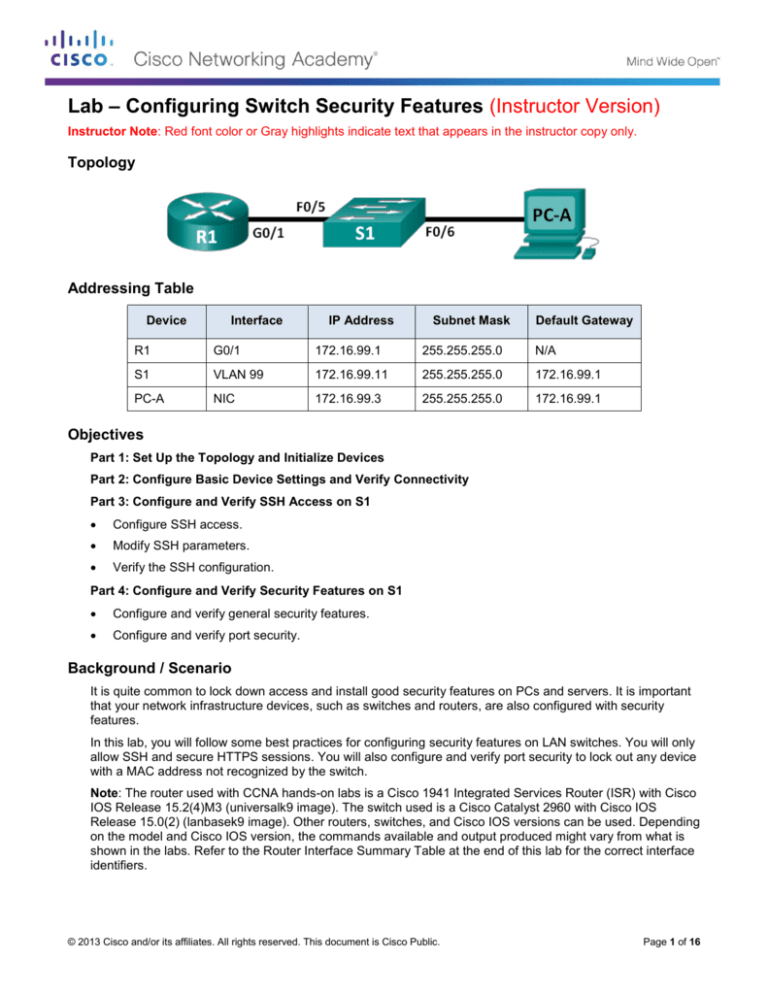
Lab – Configuring Switch Security Features (Instructor Version)
Instructor Note: Red font color or Gray highlights indicate text that appears in the instructor copy only.
Topology
Addressing Table
Device
Interface
IP Address
Subnet Mask
Default Gateway
R1
G0/1
172.16.99.1
255.255.255.0
N/A
S1
VLAN 99
172.16.99.11
255.255.255.0
172.16.99.1
PC-A
NIC
172.16.99.3
255.255.255.0
172.16.99.1
Objectives
Part 1: Set Up the Topology and Initialize Devices
Part 2: Configure Basic Device Settings and Verify Connectivity
Part 3: Configure and Verify SSH Access on S1
Configure SSH access.
Modify SSH parameters.
Verify the SSH configuration.
Part 4: Configure and Verify Security Features on S1
Configure and verify general security features.
Configure and verify port security.
Background / Scenario
It is quite common to lock down access and install good security features on PCs and servers. It is important
that your network infrastructure devices, such as switches and routers, are also configured with security
features.
In this lab, you will follow some best practices for configuring security features on LAN switches. You will only
allow SSH and secure HTTPS sessions. You will also configure and verify port security to lock out any device
with a MAC address not recognized by the switch.
Note: The router used with CCNA hands-on labs is a Cisco 1941 Integrated Services Router (ISR) with Cisco
IOS Release 15.2(4)M3 (universalk9 image). The switch used is a Cisco Catalyst 2960 with Cisco IOS
Release 15.0(2) (lanbasek9 image). Other routers, switches, and Cisco IOS versions can be used. Depending
on the model and Cisco IOS version, the commands available and output produced might vary from what is
shown in the labs. Refer to the Router Interface Summary Table at the end of this lab for the correct interface
identifiers.
© 2013 Cisco and/or its affiliates. All rights reserved. This document is Cisco Public.
Page 1 of 16
Lab – Configuring Switch Security Features
Note: Make sure that the router and switch have been erased and have no startup configurations. If you are
unsure, contact your instructor or refer to the previous lab for the procedures to initialize and reload devices.
Instructor Note: Refer to the Instructor Lab Manual for the procedures to initialize and reload devices.
Required Resources
1 Router (Cisco 1941 with Cisco IOS Release 15.2(4)M3 universal image or comparable)
1 Switch (Cisco 2960 with Cisco IOS Release 15.0(2) lanbasek9 image or comparable)
1 PC (Windows 7, Vista, or XP with terminal emulation program, such as Tera Term)
Console cables to configure the Cisco IOS devices via the console ports
Ethernet cables as shown in the topology
Part 1: Set Up the Topology and Initialize Devices
In Part 1, you will set up the network topology and clear any configurations if necessary.
Step 1: Cable the network as shown in the topology.
Step 2: Initialize and reload the router and switch.
If configuration files were previously saved on the router or switch, initialize and reload these devices back to
their basic configurations.
Part 2: Configure Basic Device Settings and Verify Connectivity
In Part 2, you configure basic settings on the router, switch, and PC. Refer to the Topology and Addressing
Table at the beginning of this lab for device names and address information.
Step 1: Configure an IP address on PC-A.
Step 2: Configure basic settings on R1.
a. Configure the device name.
b. Disable DNS lookup.
c.
Configure interface IP address as shown in the Addressing Table.
d. Assign class as the privileged EXEC mode password.
e. Assign cisco as the console and vty password and enable login.
f.
Encrypt plain text passwords.
g. Save the running configuration to startup configuration.
Step 3: Configure basic settings on S1.
A good security practice is to assign the management IP address of the switch to a VLAN other than VLAN 1
(or any other data VLAN with end users). In this step, you will create VLAN 99 on the switch and assign it an
IP address.
a. Configure the device name.
b. Disable DNS lookup.
c.
Assign class as the privileged EXEC mode password.
© 2013 Cisco and/or its affiliates. All rights reserved. This document is Cisco Public.
Page 2 of 16
Lab – Configuring Switch Security Features
d. Assign cisco as the console and vty password and then enable login.
e. Configure a default gateway for S1 using the IP address of R1.
f.
Encrypt plain text passwords.
g. Save the running configuration to startup configuration.
h. Create VLAN 99 on the switch and name it Management.
S1(config)# vlan 99
S1(config-vlan)# name Management
S1(config-vlan)# exit
S1(config)#
i.
Configure the VLAN 99 management interface IP address, as shown in the Addressing Table, and enable
the interface.
S1(config)# interface vlan 99
S1(config-if)# ip address 172.16.99.11 255.255.255.0
S1(config-if)# no shutdown
S1(config-if)# end
S1#
j.
Issue the show vlan command on S1. What is the status of VLAN 99? ______________________ Active
k.
Issue the show ip interface brief command on S1. What is the status and protocol for management
interface VLAN 99?
____________________________________________________________________________________
Status is up, and protocol is down.
Why is the protocol down, even though you issued the no shutdown command for interface VLAN 99?
____________________________________________________________________________________
No physical ports on the switch have been assigned to VLAN 99.
l.
Assign ports F0/5 and F0/6 to VLAN 99 on the switch.
S1# config t
S1(config)# interface f0/5
S1(config-if)# switchport mode access
S1(config-if)# switchport access vlan 99
S1(config-if)# interface f0/6
S1(config-if)# switchport mode access
S1(config-if)# switchport access vlan 99
S1(config-if)# end
m. Issue the show ip interface brief command on S1. What is the status and protocol showing for interface
VLAN 99? _______________________________________________ Up and up
Note: There may be a delay while the port states converge.
Step 4: Verify connectivity between devices.
a. From PC-A, ping the default gateway address on R1. Were your pings successful? ______________ Yes
b. From PC-A, ping the management address of S1. Were your pings successful? ______________ Yes
c.
From S1, ping the default gateway address on R1. Were your pings successful? ______________ Yes
© 2013 Cisco and/or its affiliates. All rights reserved. This document is Cisco Public.
Page 3 of 16
Lab – Configuring Switch Security Features
d. From PC-A, open a web browser and go to http://172.16.99.11. If it prompts you for a username and
password, leave the username blank and use class for the password. If it prompts for secured
connection, answer No. Were you able to access the web interface on S1? ______________ Yes
e. Close the browser session on PC-A.
Note: The non-secure web interface (HTTP server) on a Cisco 2960 switch is enabled by default. A common
security measure is to disable this service, as described in Part 4.
Part 3: Configure and Verify SSH Access on S1
Step 1: Configure SSH access on S1.
a. Enable SSH on S1. From global configuration mode, create a domain name of CCNA-Lab.com.
S1(config)# ip domain-name CCNA-Lab.com
b. Create a local user database entry for use when connecting to the switch via SSH. The user should have
administrative level access.
Note: The password used here is NOT a strong password. It is merely being used for lab purposes.
S1(config)# username admin privilege 15 secret sshadmin
c.
Configure the transport input for the vty lines to allow SSH connections only, and use the local database
for authentication.
S1(config)# line
S1(config-line)#
S1(config-line)#
S1(config-line)#
vty 0 15
transport input ssh
login local
exit
d. Generate an RSA crypto key using a modulus of 1024 bits.
S1(config)# crypto key generate rsa modulus 1024
The name for the keys will be: S1.CCNA-Lab.com
% The key modulus size is 1024 bits
% Generating 1024 bit RSA keys, keys will be non-exportable...
[OK] (elapsed time was 3 seconds)
S1(config)#
S1(config)# end
e. Verify the SSH configuration and answer the questions below.
S1# show ip ssh
SSH Enabled - version 1.99
Authentication timeout: 120 secs; Authentication retries: 3
Minimum expected Diffie Hellman key size : 1024 bits
IOS Keys in SECSH format(ssh-rsa, base64 encoded):
ssh-rsa AAAAB3NzaC1yc2EAAAADAQABAAAAgQCKWqCN0g4XLVdJJUOr+9qoJkFqC/g0OuAV1semrR5/
xy0bbUBPywvqhwSPJtucIKxKw/YfrRCeFwY+dc+/jGSeckAHahuv0jJfOdFcgqiKGeeluAu+iQ2drE+k
butnlLTGmtNhdEJMxri/ZeO3BsFcnHpO1hbB6Vsm4XRXGk7OfQ==
What version of SSH is the switch using? _______________________ 1.99
How many authentication attempts does SSH allow? _______________________ 3
© 2013 Cisco and/or its affiliates. All rights reserved. This document is Cisco Public.
Page 4 of 16
Lab – Configuring Switch Security Features
What is the default timeout setting for SSH? _______________________ 120 seconds
Step 2: Modify the SSH configuration on S1.
Modify the default SSH configuration.
S1# config t
S1(config)# ip ssh time-out 75
S1(config)# ip ssh authentication-retries 2
S1# show ip ssh
SSH Enabled - version 1.99
Authentication timeout: 75 secs; Authentication retries: 2
Minimum expected Diffie Hellman key size : 1024 bits
IOS Keys in SECSH format(ssh-rsa, base64 encoded):
ssh-rsa AAAAB3NzaC1yc2EAAAADAQABAAAAgQCKWqCN0g4XLVdJJUOr+9qoJkFqC/g0OuAV1semrR5/
xy0bbUBPywvqhwSPJtucIKxKw/YfrRCeFwY+dc+/jGSeckAHahuv0jJfOdFcgqiKGeeluAu+iQ2drE+k
butnlLTGmtNhdEJMxri/ZeO3BsFcnHpO1hbB6Vsm4XRXGk7OfQ==
How many authentication attempts does SSH allow? _______________________ 2
What is the timeout setting for SSH? _______________________ 75 seconds
Step 3: Verify the SSH configuration on S1.
a. Using SSH client software on PC-A (such as Tera Term), open an SSH connection to S1. If you receive a
message on your SSH client regarding the host key, accept it. Log in with admin for username and cisco
for the password.
Was the connection successful? _________________________ Yes
What prompt was displayed on S1? Why?
____________________________________________________________________________________
____________________________________________________________________________________
____________________________________________________________________________________
S1 is showing the prompt at privileged EXEC mode because the privilege 15 option was used when
configuring username and password
b. Type exit to end the SSH session on S1.
Part 4: Configure and Verify Security Features on S1
In Part 4, you will shut down unused ports, turn off certain services running on the switch, and configure port
security based on MAC addresses. Switches can be subject to MAC address table overflow attacks, MAC
spoofing attacks, and unauthorized connections to switch ports. You will configure port security to limit the
number of MAC addresses that can be learned on a switch port and disable the port if that number is
exceeded.
Step 1: Configure general security features on S1.
a. Configure a message of the day (MOTD) banner on S1 with an appropriate security warning message.
b. Issue a show ip interface brief command on S1. What physical ports are up?
____________________________________________________________________________________
Ports F0/5 and F0/6
© 2013 Cisco and/or its affiliates. All rights reserved. This document is Cisco Public.
Page 5 of 16
Lab – Configuring Switch Security Features
c.
Shut down all unused physical ports on the switch. Use the interface range command.
S1(config)# interface range f0/1 – 4
S1(config-if-range)# shutdown
S1(config-if-range)# interface range f0/7 – 24
S1(config-if-range)# shutdown
S1(config-if-range)# interface range g0/1 – 2
S1(config-if-range)# shutdown
S1(config-if-range)# end
S1#
d. Issue the show ip interface brief command on S1. What is the status of ports F0/1 to F0/4?
____________________________________________________________________________________
Administratively down.
e. Issue the show ip http server status command.
S1# show ip http server status
HTTP server status: Enabled
HTTP server port: 80
HTTP server authentication method: enable
HTTP server access class: 0
HTTP server base path: flash:html
HTTP server help root:
Maximum number of concurrent server connections allowed: 16
Server idle time-out: 180 seconds
Server life time-out: 180 seconds
Maximum number of requests allowed on a connection: 25
HTTP server active session modules: ALL
HTTP secure server capability: Present
HTTP secure server status: Enabled
HTTP secure server port: 443
HTTP secure server ciphersuite: 3des-ede-cbc-sha des-cbc-sha rc4-128-md5 rc4-128-sha
HTTP secure server client authentication: Disabled
HTTP secure server trustpoint:
HTTP secure server active session modules: ALL
What is the HTTP server status? ___________________________ Enabled
What server port is it using? ___________________________ 80
What is the HTTP secure server status? ___________________________ Enabled
What secure server port is it using? ___________________________ 443
f.
HTTP sessions send everything in plain text. You will disable the HTTP service running on S1.
S1(config)# no ip http server
g. From PC-A, open a web browser session to http://172.16.99.11. What was your result?
____________________________________________________________________________________
The web page could not open. HTTP connections are now refused by S1.
h. From PC-A, open a secure web browser session at https://172.16.99.11. Accept the certificate. Log in
with no username and a password of class. What was your result?
© 2013 Cisco and/or its affiliates. All rights reserved. This document is Cisco Public.
Page 6 of 16
Lab – Configuring Switch Security Features
____________________________________________________________________________________
Secure web session was successful.
i.
Close the web session on PC-A.
Step 2: Configure and verify port security on S1.
a. Record the R1 G0/1 MAC address. From the R1 CLI, use the show interface g0/1 command and record
the MAC address of the interface.
R1# show interface g0/1
GigabitEthernet0/1 is up, line protocol is up
Hardware is CN Gigabit Ethernet, address is 30f7.0da3.1821 (bia
3047.0da3.1821)
What is the MAC address of the R1 G0/1 interface?
____________________________________________________________________________________
In the example above, it is 30f7.0da3.1821
b. From the S1 CLI, issue a show mac address-table command from privileged EXEC mode. Find the
dynamic entries for ports F0/5 and F0/6. Record them below.
F0/5 MAC address: ______________________________________________________ 30f7.0da3.1821
F0/6 MAC address: ______________________________________________________ 00e0.b857.1ccd
c.
Configure basic port security.
Note: This procedure would normally be performed on all access ports on the switch. F0/5 is shown here
as an example.
1) From the S1 CLI, enter interface configuration mode for the port that connects to R1.
S1(config)# interface f0/5
2) Shut down the port.
S1(config-if)# shutdown
3) Enable port security on F0/5.
S1(config-if)# switchport port-security
Note: Entering the switchport port-security command sets the maximum MAC addresses to 1 and the
violation action to shutdown. The switchport port-security maximum and switchport port-security
violation commands can be used to change the default behavior.
4) Configure a static entry for the MAC address of R1 G0/1 interface recorded in Step 2a.
S1(config-if)# switchport port-security mac-address xxxx.xxxx.xxxx
(xxxx.xxxx.xxxx is the actual MAC address of the router G0/1 interface)
Note: Optionally, you can use the switchport port-security mac-address sticky command to
add all the secure MAC addresses that are dynamically learned on a port (up to the maximum set) to the
switch running configuration.
5) Enable the switch port.
S1(config-if)# no shutdown
S1(config-if)# end
d. Verify port security on S1 F0/5 by issuing a show port-security interface command.
S1# show port-security interface f0/5
© 2013 Cisco and/or its affiliates. All rights reserved. This document is Cisco Public.
Page 7 of 16
Lab – Configuring Switch Security Features
Port Security
Port Status
Violation Mode
Aging Time
Aging Type
SecureStatic Address Aging
Maximum MAC Addresses
Total MAC Addresses
Configured MAC Addresses
Sticky MAC Addresses
Last Source Address:Vlan
Security Violation Count
:
:
:
:
:
:
:
:
:
:
:
:
Enabled
Secure-up
Shutdown
0 mins
Absolute
Disabled
1
1
1
0
0000.0000.0000:0
0
What is the port status of F0/5?
____________________________________________________________________________________
The status is Secure-up, which indicates that the port is secure, but the status and protocol are up.
e. From R1 command prompt, ping PC-A to verify connectivity.
R1# ping 172.16.99.3
f.
You will now violate security by changing the MAC address on the router interface. Enter interface
configuration mode for G0/1 and shut it down.
R1# config t
R1(config)# interface g0/1
R1(config-if)# shutdown
g. Configure a new MAC address for the interface, using aaaa.bbbb.cccc as the address.
R1(config-if)# mac-address aaaa.bbbb.cccc
h. If possible, have a console connection open on S1 at the same time that you do this step. You will see
various messages displayed on the console connection to S1 indicating a security violation. Enable the
G0/1 interface on R1.
R1(config-if)# no shutdown
i.
From R1 privileged EXEC mode, ping PC-A. Was the ping successful? Why or why not?
____________________________________________________________________________________
No, the F0/5 port on S1 is shut down because of the security violation.
j.
On the switch, verify port security with the following commands shown below.
S1# show port-security
Secure Port MaxSecureAddr CurrentAddr SecurityViolation Security Action
(Count)
(Count)
(Count)
-------------------------------------------------------------------Fa0/5
1
1
1
Shutdown
---------------------------------------------------------------------Total Addresses in System (excluding one mac per port)
:0
Max Addresses limit in System (excluding one mac per port) :8192
S1# show port-security interface f0/5
Port Security
Port Status
: Enabled
: Secure-shutdown
© 2013 Cisco and/or its affiliates. All rights reserved. This document is Cisco Public.
Page 8 of 16
Lab – Configuring Switch Security Features
Violation Mode
Aging Time
Aging Type
SecureStatic Address Aging
Maximum MAC Addresses
Total MAC Addresses
Configured MAC Addresses
Sticky MAC Addresses
Last Source Address:Vlan
Security Violation Count
:
:
:
:
:
:
:
:
:
:
Shutdown
0 mins
Absolute
Disabled
1
1
1
0
aaaa.bbbb.cccc:99
1
S1# show interface f0/5
FastEthernet0/5 is down, line protocol is down (err-disabled)
Hardware is Fast Ethernet, address is 0cd9.96e2.3d05 (bia 0cd9.96e2.3d05)
MTU 1500 bytes, BW 10000 Kbit/sec, DLY 1000 usec,
reliability 255/255, txload 1/255, rxload 1/255
<output omitted>
S1# show port-security address
Secure Mac Address Table
-----------------------------------------------------------------------Vlan
Mac Address
Type
Ports
Remaining Age
(mins)
--------------------------------99
30f7.0da3.1821
SecureConfigured
Fa0/5
----------------------------------------------------------------------Total Addresses in System (excluding one mac per port)
:0
Max Addresses limit in System (excluding one mac per port) :8192
k.
On the router, shut down the G0/1 interface, remove the hard-coded MAC address from the router, and
re-enable the G0/1 interface.
R1(config-if)#
R1(config-if)#
R1(config-if)#
R1(config-if)#
l.
shutdown
no mac-address aaaa.bbbb.cccc
no shutdown
end
From R1, ping PC-A again at 172.16.99.3. Was the ping successful? _________________ No
m. Issue the show interface f0/5 command to determine the cause of ping failure. Record your findings.
____________________________________________________________________________________
F0/5 port on S1 is still in an error disabled state.
S1# show interface f0/5
FastEthernet0/5 is down, line protocol is down (err-disabled)
Hardware is Fast Ethernet, address is 0023.5d59.9185 (bia 0023.5d59.9185)
MTU 1500 bytes, BW 10000 Kbit/sec, DLY 1000 usec,
reliability 255/255, txload 1/255, rxload 1/255
n. Clear the S1 F0/5 error disabled status.
S1# config t
© 2013 Cisco and/or its affiliates. All rights reserved. This document is Cisco Public.
Page 9 of 16
Lab – Configuring Switch Security Features
S1(config)# interface f0/5
S1(config-if)# shutdown
S1(config-if)# no shutdown
Note: There may be a delay while the port states converge.
o. Issue the show interface f0/5 command on S1 to verify F0/5 is no longer in error disabled mode.
S1# show interface f0/5
FastEthernet0/5 is up, line protocol is up (connected)
Hardware is Fast Ethernet, address is 0023.5d59.9185 (bia 0023.5d59.9185)
MTU 1500 bytes, BW 100000 Kbit/sec, DLY 100 usec,
reliability 255/255, txload 1/255, rxload 1/255
p. From the R1 command prompt, ping PC-A again. You should be successful.
Reflection
1. Why would you enable port security on a switch?
_______________________________________________________________________________________
It would help prevent unauthorized devices from accessing your network if they plugged into a switch on your
network.
2. Why should unused ports on a switch be disabled?
_______________________________________________________________________________________
One excellent reason is that a user could not connect a device to the switch on an unused port and access
the LAN.
© 2013 Cisco and/or its affiliates. All rights reserved. This document is Cisco Public.
Page 10 of 16
Lab – Configuring Switch Security Features
Router Interface Summary Table
Router Interface Summary
Router Model
Ethernet Interface #1
Ethernet Interface #2
Serial Interface #1
Serial Interface #2
1800
Fast Ethernet 0/0
(F0/0)
Fast Ethernet 0/1
(F0/1)
Serial 0/0/0 (S0/0/0)
Serial 0/0/1 (S0/0/1)
1900
Gigabit Ethernet 0/0
(G0/0)
Gigabit Ethernet 0/1
(G0/1)
Serial 0/0/0 (S0/0/0)
Serial 0/0/1 (S0/0/1)
2801
Fast Ethernet 0/0
(F0/0)
Fast Ethernet 0/1
(F0/1)
Serial 0/1/0 (S0/1/0)
Serial 0/1/1 (S0/1/1)
2811
Fast Ethernet 0/0
(F0/0)
Fast Ethernet 0/1
(F0/1)
Serial 0/0/0 (S0/0/0)
Serial 0/0/1 (S0/0/1)
2900
Gigabit Ethernet 0/0
(G0/0)
Gigabit Ethernet 0/1
(G0/1)
Serial 0/0/0 (S0/0/0)
Serial 0/0/1 (S0/0/1)
Note: To find out how the router is configured, look at the interfaces to identify the type of router and how many
interfaces the router has. There is no way to effectively list all the combinations of configurations for each router
class. This table includes identifiers for the possible combinations of Ethernet and Serial interfaces in the device.
The table does not include any other type of interface, even though a specific router may contain one. An
example of this might be an ISDN BRI interface. The string in parenthesis is the legal abbreviation that can be
used in Cisco IOS commands to represent the interface.
Device Configs
Router R1
R1#sh run
Building configuration...
Current configuration : 1232 bytes
!
version 15.2
service timestamps debug datetime msec
service timestamps log datetime msec
service password-encryption
!
hostname R1
!
enable secret 4 06YFDUHH61wAE/kLkDq9BGho1QM5EnRtoyr8cHAUg.2
!
no ip domain-lookup
!
interface GigabitEthernet0/0
no ip address
shutdown
duplex auto
speed auto
!
interface GigabitEthernet0/1
© 2013 Cisco and/or its affiliates. All rights reserved. This document is Cisco Public.
Page 11 of 16
Lab – Configuring Switch Security Features
ip address 172.16.99.1 255.255.255.0
duplex auto
speed auto
!
interface Serial0/0/0
no ip address
shutdown
clock rate 2000000
!
interface Serial0/0/1
no ip address
shutdown
clock rate 2000000
ip forward-protocol nd
!
no ip http server
no ip http secure-server
!
!
!
!
!
control-plane
!
!
!line con 0
password 7 030752180500
login
line aux 0
line 2
no activation-character
no exec
transport preferred none
transport input all
transport output pad telnet rlogin lapb-ta mop udptn v120 ssh
stopbits 1
line 67
no activation-character
no exec
transport preferred none
transport input all
transport output pad telnet rlogin lapb-ta mop udptn v120 ssh
line vty 0 4
password 7 13061E01080344
login
transport input all
!
scheduler allocate 20000 1000
!
© 2013 Cisco and/or its affiliates. All rights reserved. This document is Cisco Public.
Page 12 of 16
Lab – Configuring Switch Security Features
end
Switch S1
S1#sh run
Building configuration...
Current configuration : 3762 bytes
version 15.0
no service pad
service timestamps debug datetime msec
service timestamps log datetime msec
service password-encryption
!
hostname S1
!
enable secret 4 06YFDUHH61wAE/kLkDq9BGho1QM5EnRtoyr8cHAUg.2
!
username admin privilege 15 secret 4 tnhtc92DXBhelxjYk8LWJrPV36S2i4ntXrpb4RFmfqY
!
no ip domain-lookup
ip domain-name CCNA-Lab.com
!
crypto pki trustpoint TP-self-signed-2530358400
enrollment selfsigned
subject-name cn=IOS-Self-Signed-Certificate-2530358400
revocation-check none
rsakeypair TP-self-signed-2530358400
!
crypto pki certificate chain TP-self-signed-2530358400
certificate self-signed 01
3082022B 30820194 A0030201 02020101 300D0609 2A864886 F70D0101 05050030
31312F30 2D060355 04031326 494F532D 53656C66 2D536967 6E65642D 43657274
69666963 6174652D 32353330 33353834 3030301E 170D3933 30333031 30303030
35395A17 0D323030 31303130 30303030 305A3031 312F302D 06035504 03132649
4F532D53 656C662D 5369676E 65642D43 65727469 66696361 74652D32 35333033
35383430 3030819F 300D0609 2A864886 F70D0101 01050003 818D0030 81890281
8100C0E3 1B8AF1E4 ADA4C4AD F82914AF BF8BCEC9 30CFBF54 D76B3940 38353E50
A9AE0FCE 9CA05B91 24312B31 22D5F89D D249023E AEEC442D F55315F6 D456DA95
16B758FB 8083B681 C1B3A3BF 99420EC7 A7E0AD11 CF031CD1 36A997C0 E72BE4DD
1D745542 1DC958C1 443B6727 F7047747 D94B8CAD 0A99CBDC ADC914C8 D820DC30
E6B70203 010001A3 53305130 0F060355 1D130101 FF040530 030101FF 301F0603
551D2304 18301680 1464D1A8 83DEE145 E35D68C1 D078ED7D 4F6F0B82 9D301D06
03551D0E 04160414 64D1A883 DEE145E3 5D68C1D0 78ED7D4F 6F0B829D 300D0609
2A864886 F70D0101 05050003 81810098 D65CFA1C 3942148D 8961D845 51D53202
EA59B526 7DB308C9 F79859A0 D93D56D6 C584AB83 941A2B7F C44C0E2F DFAF6B8D
A3272A5C 2363116E 1AA246DD 7E54B680 2ABB1F2D 26921529 E1EF4ACC A4FBD14A
BAD41C98 E8D83DEC B85A330E D453510D 89F64023 7B9782E7 200F615A 6961827F
8419A84F 56D71664 5123B591 A62C55
quit
!
© 2013 Cisco and/or its affiliates. All rights reserved. This document is Cisco Public.
Page 13 of 16
Lab – Configuring Switch Security Features
ip ssh time-out 75
ip ssh authentication-retries 2
!
interface FastEthernet0/1
shutdown
!
interface FastEthernet0/2
shutdown
!
interface FastEthernet0/3
shutdown
!
interface FastEthernet0/4
shutdown
!
interface FastEthernet0/5
switchport access vlan 99
switchport mode access
switchport port-security
switchport port-security mac-address 30f7.0da3.1821
!
interface FastEthernet0/6
switchport access vlan 99
switchport mode access
!
interface FastEthernet0/7
shutdown
interface
shutdown
!
interface
shutdown
!
interface
shutdown
!
interface
shutdown
!
interface
shutdown
!
interface
shutdown
!
interface
shutdown
!
FastEthernet0/8
FastEthernet0/9
FastEthernet0/10
FastEthernet0/11
FastEthernet0/12
FastEthernet0/13
FastEthernet0/14
© 2013 Cisco and/or its affiliates. All rights reserved. This document is Cisco Public.
Page 14 of 16
Lab – Configuring Switch Security Features
interface FastEthernet0/15
shutdown
!
interface FastEthernet0/16
shutdown
!
interface FastEthernet0/17
shutdown
!
interface FastEthernet0/18
shutdown
!
interface FastEthernet0/19
shutdown
!
interface FastEthernet0/20
shutdown
!
interface FastEthernet0/21
shutdown
!
interface FastEthernet0/22
shutdown
!
interface FastEthernet0/23
shutdown
!
interface FastEthernet0/24
shutdown
!
interface GigabitEthernet0/1
shutdown
!
interface GigabitEthernet0/2
shutdown
!
interface Vlan1
no ip address
shutdown
!
interface Vlan99
ip address 172.16.99.11 255.255.255.0
!
ip default-gateway 172.16.99.1
no ip http server
ip http secure-server
!
banner motd ^CWarning! Unauthorized Access is Prohibited.^C
!
© 2013 Cisco and/or its affiliates. All rights reserved. This document is Cisco Public.
Page 15 of 16
Lab – Configuring Switch Security Features
line con 0
password cisco
logging synchronous
login
line vty 0 4
login local
transport input ssh
line vty 5 15
login local
transport input ssh
!
end
© 2013 Cisco and/or its affiliates. All rights reserved. This document is Cisco Public.
Page 16 of 16


